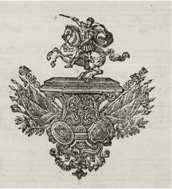 Come and hear Dr Hazel Wilkinson describe her work on “The Digital Life of Decorated Books” at 5.30 p.m. on Wednesday 28 March in Burns 5 on the ground floor of the Arts Building.
Come and hear Dr Hazel Wilkinson describe her work on “The Digital Life of Decorated Books” at 5.30 p.m. on Wednesday 28 March in Burns 5 on the ground floor of the Arts Building.
Dr Wilkinson, from the Department of English, University of Birmingham, is a scholar of eighteenth-century literature and print history and Principal Investigator on Fleuron. Fleuron (@Fleuronweb) is an open access database of eighteenth-century printers’ ornaments. It allows users to explore the history of print and publishing through the decorative elements used to adorn books of this period.
She has kindly provided the following summary and abstract:
Summary: This talk is about printers’ ornaments, the images made from inked wood- or metal-cut designs that regularly decorated printed books in the hand-press period. The talk will introduce an online database of printers’ ornaments, and discuss the growing importance of printers’ ornaments in literary studies and related fields.
Abstract: In 2016, ‘Fleuron’, a database of c.1.5 million eighteenth-century printers’ ornaments and related images, was launched online at fleuron.lib.cam.ac.uk. This talk will begin by describing how ‘Fleuron’ was created, with an introduction to the digital methods behind the database (accessible to non-specialists). ‘Fleuron’ was originally built as a tool for bibliographers, particularly those working in the field of printer identification. The talk will show how printers’ ornaments can be used to identify unknown printers, and will address the advantages and pitfalls of doing this kind of work digitally. It will outline plans for the project’s future, including the use of computer vision and machine learning. Beyond its bibliographical applications, ‘Fleuron’ is an exciting tool for the history of art and design: printers’ ornaments are miniature works of art that have been sorely neglected, perhaps because they have fallen through the conceptual gap between “text” and “illustration”. The talk will conclude with a discussion of the conceptual difficulty posed by ornaments. How do we distinguish between the illustrative and the decorative? What roles might ornaments have played in the interpretation of hand-press period texts at their first appearance? How can we “read” printers’ ornaments? The visual turn in literary studies is leading textual editors to ask these sorts of questions, and we are beginning to feel the need for an interpretative vocabulary for ornaments, for both research and teaching. The creative use of digital tools will be integral to the shaping of this new critical vocabulary.
Keith Maslen, an Honorary Fellow of the Department of English and Linguistics here, is one of the top bibliographers to have studied ornaments for handpress printer identification, so it is a great pleasure to be able to hear from Dr. Wilkinson about where the future of such scholarship might lead.

